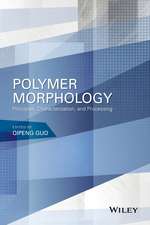Specialty Polymers
Editat de R. W. Dysonen Limba Engleză Paperback – 28 sep 2011
| Toate formatele și edițiile | Preț | Express |
|---|---|---|
| Paperback (1) | 639.41 lei 6-8 săpt. | |
| SPRINGER NETHERLANDS – 28 sep 2011 | 639.41 lei 6-8 săpt. | |
| Hardback (1) | 645.60 lei 6-8 săpt. | |
| SPRINGER NETHERLANDS – 31 dec 1997 | 645.60 lei 6-8 săpt. |
Preț: 639.41 lei
Preț vechi: 752.24 lei
-15% Nou
Puncte Express: 959
Preț estimativ în valută:
122.36€ • 128.33$ • 101.86£
122.36€ • 128.33$ • 101.86£
Carte tipărită la comandă
Livrare economică 01-15 aprilie
Preluare comenzi: 021 569.72.76
Specificații
ISBN-13: 9789401064996
ISBN-10: 9401064997
Pagini: 276
Ilustrații: 280 p.
Dimensiuni: 155 x 235 x 14 mm
Greutate: 0.39 kg
Ediția:2nd ed. 1997. Softcover reprint of the original 2nd ed. 1998
Editura: SPRINGER NETHERLANDS
Colecția Springer
Locul publicării:Dordrecht, Netherlands
ISBN-10: 9401064997
Pagini: 276
Ilustrații: 280 p.
Dimensiuni: 155 x 235 x 14 mm
Greutate: 0.39 kg
Ediția:2nd ed. 1997. Softcover reprint of the original 2nd ed. 1998
Editura: SPRINGER NETHERLANDS
Colecția Springer
Locul publicării:Dordrecht, Netherlands
Public țintă
ResearchCuprins
1 Polymer structures and general properties.- 1.1 Introduction.- 1.2 Polymer structures.- 1.3 Morphology and softening behaviour.- 1.4 Amorphous polymers and softening behaviour.- 1.5 Semi-crystalline polymers and softening behaviour.- 1.6 Molecular weight.- 1.7 Copolymers.- 1.8 Chemical behaviour.- 1.9 Solubility.- 1.10 Electrical properties.- 1.11 Conclusion.- Further reading.- 2 Polymerization.- 2.1 Introduction.- 2.2 Addition polymerization.- 2.3 Step-growth polymerization.- 2.4 Copolymer formation.- 2.5 Chemical conversion.- 2.6 Polyblends.- 2.7 Conclusion.- 3 High-temperature and fire resistant polymers.- 3.1 Introduction.- 3.2 The need for thermally resistant polymers.- 3.3 Improving low-performance polymers for high-temperature use.- 3.4 The need for fire resistant polymers.- 3.5 Polymers for low fire-hazards.- 3.6 Polymers for high-temperature resistance.- 3.7 Heterocyclic polymers.- Further reading.- 4 Hydrophilic polymers.- 4.1 Introduction.- 4.2 Natural polymers.- 4.3 Semisynthetic polymers.- 4.4 Synthetic polymers.- 4.5 Superabsorbent polymers.- Further reading.- 5 Polymers with electrical and electronic properties.- 5.1 Introduction.- 5.2 Conducting polymers.- 5.3 Photoconducting polymers.- 5.4 Polymers in optoelectronics.- 5.5 Polymers with piezoelectric, pyroelectric and ferroelectric properties.- 5.6 Photoresists for semiconductor fabrication.- 5.7 Summary and conclusions.- References.- 6 Ionic layers.- 6.1 Introduction.- 6.2 Classification.- 6.3 Synthesis.- 6.4 Physical properties and applications.- 6.5 Ionomers based on polyethylene.- 6.6 Elastomeric ionomers.- 6.7 Ionomers based on polystyrene.- 6.8 Ionomers based on polytetrafluoroethylene.- 6.9 Ionomer with polyaromatic backbones.- 6.10 Polyelectrolytes for ion exchange.- 6.11 Polyelectrolytes based on carboxylates.- 6.12 Polymers with integral ions.- 6.13 Polyelectrolyte complexes.- 6.14 Blends of polymers and salts.- 6.15 Biological and inorganic ionic polymers.- 6.16 Conclusions.- References.- 7 Liquid crystal polymers.- 7.1 Introduction to thermotropie liquid crystals.- 7.2 Liquid crystal polymers.- 7.3 The structure of side-group liquid crystal polymers.- 7.4 Elastomeric liquid crystal polymers.- 7.5 Laterally attached liquid crystal side-group polymers.- 7.6 Cyclic polysiloxanes.- 7.7 Applications of side-group liquid polymers.- 7.8 In situ photopolymerization.- References.- 8 Structural polymers.- 8.1 Introduction.- 8.2 Introduction to composites.- 8.3 Thermosets.- 8.4 Thermoplastics.- 8.5 Recent and future directions.- Further reading.
Recenzii
about the first edition
`This is a book well worth having on your shelves. The book is so well contrived and presented that I am greedy for information from the publishers for books on other aspects of polymer technology.'
Plastics and Rubber International
`This is a book well worth having on your shelves. The book is so well contrived and presented that I am greedy for information from the publishers for books on other aspects of polymer technology.'
Plastics and Rubber International










